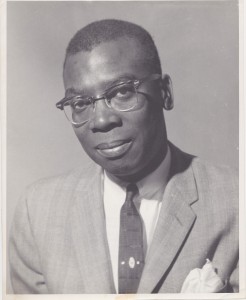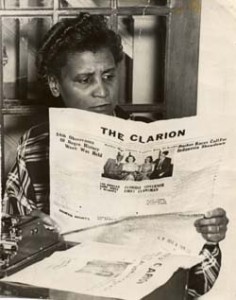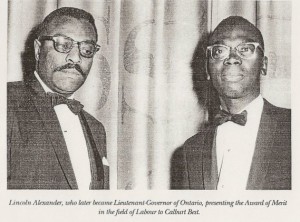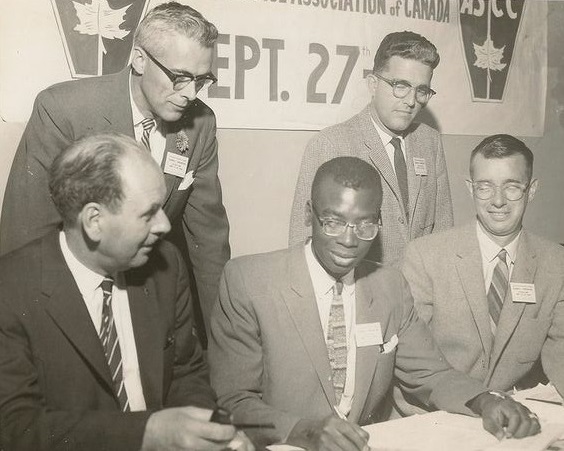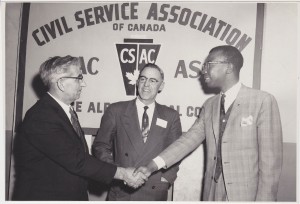Cal Best’s Life
“James Calbert Best was one of my heroes.”
Letter of support from The Honourable Donald H. Oliver, Q.C.,
Speaker pro tempore, Senate of Canada
“I am proud to say that this amazing man was Nova Scotian…”
Letter of support from Darrell E. Dexter, Q.C., Premier of Nova Scotia
James Calbert (Cal) Best was born in July 1926 in New Glasgow, Nova Scotia. He grew up in a closely knit family and was strong academically and in sports as a youth. One of his first notable experiences was that he and his mother, Carrie Best, were arrested and fined for refusing to leave the Whites Only section of the Roseland Theatre in New Glasgow when he was 12.
Carrie Best founded The Clarion, and Cal worked with her on it. It was the first
newspaper devoted to Black community issues in Nova Scotia. One of the issues it helped publicize and mobilize opinion around was the Viola Desmond case where the courts notoriously upheld the right to racial discrimination in public venues. In the 1940s there was a lot of attention across North America to ending racial and other types of discrimination, as the world approached the proclamation of the Universal Declaration of Human Rights in 1948. Local newspapers like the Clarion were vital in moving these debates from the academic and legal realms into their communities.
Cal Best studied political science and public administration at King’s College in Nova Scotia. He might have had a career in professional sports, but there were no Blacks allowed then. On graduating, he found work in Ottawa with the Department of Labour, specializing in the field of collective bargaining. The federal government oversaw bargaining in federally-regulated industries, such as railways and air travel, but did not allow its own employees to form unions or bargain their working conditions. Cal Best set out to change both of those limitations.
In 1958, he was elected President of the newly formed Civil Service Association of Canada. Its goal was to replace competing and largely ineffective employee associations with a single, democratic union capable of delivering collective bargaining results. Cal worked tirelessly, organizing, lobbying, and researching with McGill University to develop the appropriate system of collective bargaining for the civil service.
He remained president of the CSAC until 1966, when it merged with the Civil Service Federation. Between them, they had majority support in most job categories of the federal government, which allowed them for the first time to address many issues for their members. He is seen as one of the founders of the Public Service Alliance of Canada, and played a key role in the merger talks.
He left the union movement for a number of senior jobs in government. His crowning achievement was to be Canada’s first Black ambassador. After his retirement, he served on a number of commissions, notably on participation of visible minorities in the public service.
His career spans a period of almost no Black public employees, through having junior and insecure positions, to a more inclusive and representative situation today. Cal Best was a leader and is a great example for us all to the value of patient, persistent activism to leave the world a better place than we found it.
The Cal Best Project
“The Cal Best Project” celebrates the life and legacy of this extraordinary activist with a travelling exhibition that includes a documentary (Simply the Best), multi-panel bilingual educational display, and panel discussion. From his early days as a reporter covering the controversial Viola Desmond case to his tenure as Canada’s first Black High Commissioner, Best’s efforts are brought to life through interviews, archival footage, and contemporary news accounts. A special focus on Best’s commitment to a more inclusive public service examines his efforts as co-founder and president of the Civil Service Association of Canada (the precursor to today’s Public Service Alliance of Canada) and highlights the debt that thousands of Canadian public servants owe him even today.
The WHM’s explorations into Cal Best’s life started small, using parts of a panel discussion with PSAC Founders to look at the life and career of Cal Best. We soon discovered that what we knew was only the tip of the iceberg. As Arthur Carkner, coordinator of the project, recalls, “We learned about his early struggles with racism, his Nova Scotia achievements, about his mother, Carrie Best. Best’s role in immigration, amateur sport, senior positions in various government departments ending in being Canada’s first Black High Commissioner (Ambassador) gradually came to light, and we continue to learn more.”
Cal Best’s story is one we should not forget. By bringing “The Cal Best Project” to audiences across the country, we can ensure that more Canadians learn about this remarkable figure in our shared history.
Simply the Best
See an interesting documentary on the life and times of Cal Best, a major figure in 20th century Canadian Black history. In interviews and images, we see his progress from early years in New Glasgow, N.S. to being a union founder and leader, senior government official and Canada’s first Black High Commissioner (Ambassador). A man who changed the world for the better.
Double click on the URL below for more information on Simply the Best.
Note: Following access to the URL below, please click on the back arrow in the toolbar to return to the website.
